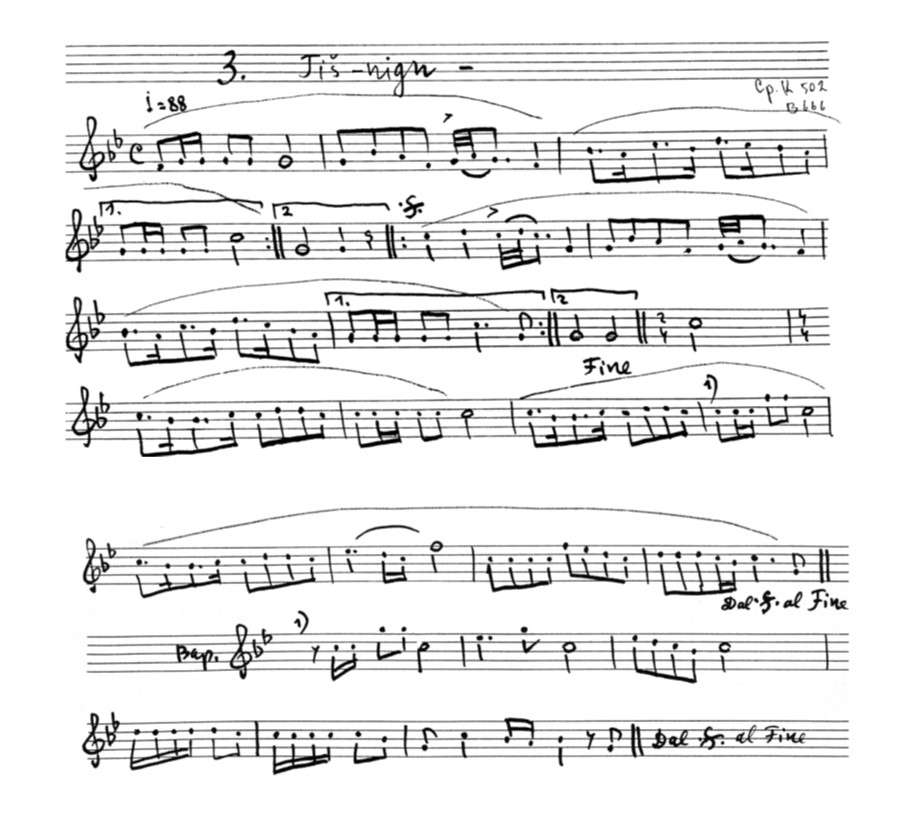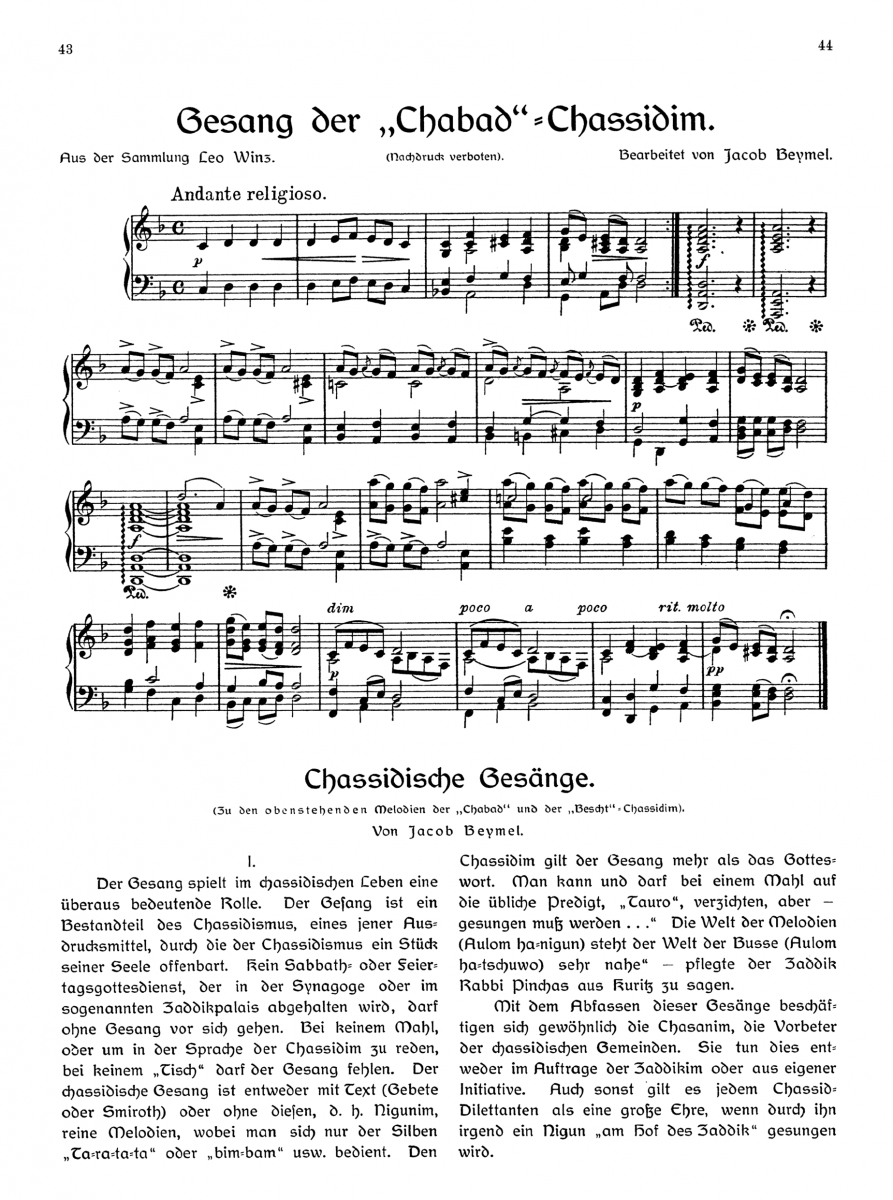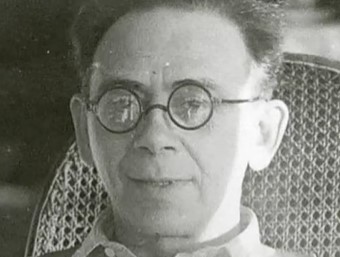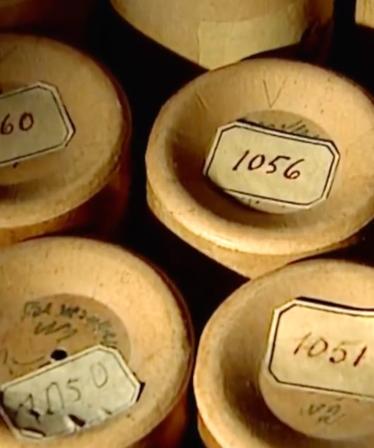M. (Moyshe/Moisei) Beregovski, Evreiskie narodnye napevy bez slov [Jewish Tunes without Words, 1946]:
This research was supported by a grant from the Ministry of Science and Technology, Israel and the Ukrainian Ministry of Education and Science (MESU)
(Published: October 2021. Updates: December 2021, January 2022. February 2022; December 2022)
M. Beregovski's, Evreiskie narodnye napevy bez slov [Jewish Tunes without Words, 1946; 1962], is one of the most important compilations of Hasidic nigunim available to this date. Yet, a full appreciation of its contents in the wider context of Hasidic music research is a desideratum. The present essay, focusing on Nign no. 3, shows the explanatory potential that each item in Beregovski's collection has when it is contextualized within the evolving knowledge about the Hasidic repertoire accumulated since its posthumous publication in 1962. This study is an ongoing project and will be updated as new information is gathered. It is part of the JMRC project of publishing a critical edition of Beregovski's collection of nigunim initiated by Yaacov Mazor and developed as an extension of the Israel-Ukraine joint project titled 'The Hasidic nign in RIght Bank Ukraine and East Galicia: Between Autochthonous and External Soundscapes' (2019-2022) carried out in collaboration with Prof. Olha Kolomyyets.
I Transcriptions and Editions

Figure 1: Nign no. 3, edition from Beregovski’s manuscript
Nign no. 3 in Beregovski’s manuscript of 1946 (see above), was published several times. It appeared in print for the first time in Beregovski’s Evreiskiie narodnyie pesni [Jewish Folk Songs] – the collection that Beregovski prepared for publication during the last years of his life but did not live to see it published. It was edited and brought to print in Moscow, 1962, by Sergei Aksiuk (no. 116). Here the nign appears in its original tonality, e minor natural.

Figure 2: Moscow edition, 1962, by Sergei Aksiuk
From this 1962 source it was reprinted in M. Beregovski, Old Jewish Folk Music: The Collections and Writings of Moshe Beregovski (edited and translated by Mark Slobin. New York, 1982, p. 462). It was later on republished in M. Beregovski, Evreiskie narodnye napevy bez slov [Jewish Folk Tunes Without Words] (Moscow, 1999, no. 3), the first edition of most tunes from Beregovski’s entire selected collection of Hassidic nigunim that remained unpublished after he completed it in 1946 as volume 4 of his planned five-volume collection of Jewish Music. The tonality was restored to g minor natural, as in Beregovski’s 1946 manuscript, in which all the tunes are transposed to the tonic G.

Figure 3: Beregovski 1999
Finally, a facsimile of this original 1946 musical notation accompanied by Beregovski’s own comments to the nign in Russian was published as a digital file in M. Beregovski, Evreiskii muzykalʹnyi folʹklor v 5-ti tomakh na CD-diskakh [Jewish Musical Folklore in 5 volumes on 5 CDs] (Kiev, 2013, CD4, no.3).

Figure 4: facsimile of 1946 musical notation accompanied by Beregovski’s comments
According to these sources, the tune was transcribed by ear by M. Beregovski himself in 1920 in Kiev; Beregovski learned it in his childhood (ca. 1900) from his father in the shtetl of Makarov, Kiev province. Below is the nign in Beregovski’s handwriting from the manuscript prepared for publication. Note that the large slurs in Beregovski’s manuscript that were reproduced in the 1999 edition are apparently analytical tools. For this reason, they do not appear in our edition above.
An additional version of the same nign that was likely available to Beregovski appears as number K1337, courtesy of the Kiselgof-Makonovestsky Digital Manuscript Project of the Klezmer Institute. Documented in 1915 from Aronson, it is titled “A Freilichs,” i.e. a dancing tune, a testimony of the porosity between vocal and instrumental repertoires of the Eastern European Jewish tradition.

Figure 5: Version of the nign documented in 1915 from Aronson
II Study
Nign no. 3 shows seven musical traits that are common to the Hassidic repertoire from Western Ukraine:
- Slow development of the melodic contour. From the three sections that compose this nign (whose overall form is ABCB), two of them (A and B), comprising three quarters of the entire tune differ only in their opening bar. Each bar in these phrases consists of two to four tones only, and each bar contains at least one tone that already appeared in the previous bar. In this way, no bar consists of tones that were not heard previously. About one third of the melody (eleven out of thirty-four bars in the actual performance) consist of bars of one or two tones only (bars nos.: 1, 4, 1, 5, 9, 10, 11, 13, 15, 9, 10), while the rest – three or four tones only.
- Asymmetric rhythmic patterns. In opposition to the limited movement of the melody, the rhythmic variability stands out. This feature brings this nign close to the Eastern European Jewish instrumental repertoire (klezmer; see above the transcription of the nign by Kiselgof as a “Freilichs”, i.e. freylekhs). The order of the rhythmic patterns is asymmetric and yet well thought out. Three main patterns (a, b, c) reoccur in different permutations while two others (e, f) appear only at the peak of the nign, coinciding with the first appearance of the sixth and seventh degrees of the melody’s ambitus, the highest pitches in the whole piece. This rhythmic-melodic peak appears in the middle of the third section out of four, creating a sort of “classic” curve:
abca-abcd || b’bca-b”bcd || signal || c’ac’a-c’efa’ || b”bca-b”bca’

Figure 6: Rhythmic structure of Nign no. 3.
- Natural minor modality with resting tones on the tonic, the subtonic, the fourth and seventh degrees, recall older strata of the Eastern European Ashkenazi music. This mode is common in prayer tunes, in the Yiddish folk song and in the old instrumental repertoire.[1] The two intervals that set this melody in motion are the second and the perfect fourth. The predominance of these two intervals represents another link to Ashkenazi prayer[2].
- Preference for overall upward melodic movement: the ascent from the subtonic to the tonic, from the tonic to the fourth degree and from there to the seventh degree, the peak of the melodic development.
- Complex form consisting, as we have already noticed, of four sections, ABCB, one of the most widespread forms of Hassidic nigunim.[3] Moreover, the peak in the third section (C), coinciding with the highest tones of the ambitus and with rhythmic novelty, is characteristic of a large number of nigunim endowing this section with a particular emotional charge. In addition, the third section is preceded by a “signal” consisting in the present case of a single long tone. This “signal” is a structural extension that has the effect of adding rhythmic drive to the launching of the emotionally charged section C.[4] Even more so, Beregovski provides an alternative version for section C, and it remains unclear as to whether this additional version is part of his father’s transmission or if it stems from another source. The alternative version offers even more rhythmic variety and even a cadence in the third degree (B flat), insinuating a switch to the parallel major scale (for more on this alternative version of section C, see below).
- Abundant structural and performative repetition. Pivotal tones in the tune are persistently repeated, rhythmic and melodic units are also repeated and the first two sections of the nign are repeated with open and closed cadences. Moreover, in actual performance, the entire nign is repeated in several cycles, at times with acceleration of tempo and increase in dynamics, adding to the ecstatic mood of the performing Hassidim.[5]
-
Openness to diverse contexts of performance. The nign can be performed while the congregation is seated, in medium tempo, in processions, such as the one accompanying the groom towards the bride in the wedding ceremony, or while dancing, in faster tempo. Indeed, this nign is still performed today in different Hassidic courts in Israel with diverse tempi, as we shall bee below.
The lack of a specific regional context of the nign transmitted within the Beregovski family and its strong connections to the Eastern European melos of the Jewish prayer, Yiddish folksong and instrumental music, enabled the distribution of this piece throughout the vast Jewish settlement in Ukraine, Poland and Russia. Thus, recent ethnographic work among Hassidim belonging to several dynasties living in Israel shows that they perform this nign assiduously. Its distribution includes the Hassidic courts of Tolna (Volyn/Volhinya, today Talne in the Cherkasy Oblast) and Vizhnitz (Vizhnytsia) of Ukraine[6] (see below Archival Recording no. 2), Karlin, Chabad (Lyadi, Lyuvabichi) and Slonim of Belarus[7] and some from the Hungarian territories.
Hereby is the Chabad version:

Figure 7: Chabad version 'Nign Hisvaadus' (See below Archival Recordings no. 1 and no. 6)
The versions of the nign in Chabad sources (written and recorded) are unique in their very slow, meditative tempo. Moreover, the Chabad version appears only in the third and much later volume of Zalmanov’s trilogy (see below note 7), suggesting perhaps that nign no. 3 entered the Chabad repertoire at a relatively later stage. Indeed members of Chabad in Israel informed Yaakov Mazor (in interviews of November 2021) that this nign was unknown among them until it was “imported” by Chabad hassidim from Brooklyn, New York. According to these testimonies, our nign could have been adopted by Chabad in the USA rather than in Europe.
However, fresh evidence seems to point otherwise. The retrieval (January 2022) of the manuscript of an unpublished piece titled Chassidische Rhapsodie for choir a capella (undated) by Arno Nadel in his personal archive at the Eric Mandel Collection of Gratz College in Philadelphia shows that the composer knew the nign as a 'Chabad Melodie' (see Figure 8). Nadel sets the tempo and mood of his piece as 'Langsam, mystisch' ('Slow, mystic') akin to the tempo and mood of the Chabad oral tradition.
As it turns, Nadel had in front of him a specific source for this choral composition. In the January 1908 issue of the important periodical Ost und West, composer, educator and musicologist Jacob Beimel (spelled Beymel in this source) published the same Chabad nign in his own arrangement for piano (see the third image in Figure 8). Marked as 'Andante religioso,' it is quoted verbatim by Nadel. Beimel had access to the Jewish folk music collection of Leo Winz (1876-1952), the founder of Ost und West. Winz had accumulated a substantial collection of Eastern European Jewish music transcriptions that composers residing in Berlin in the first decades of the twentieth century, such as Beimel and Nadel, arranged and published in the pages of his journal. Winz's source for this nign is yet unknown. This evidence takes the journey of the opening section of nign no. 3 further back into the late nineteenth century.



Figure 8: Arno Nadel, 'Chassidische Rhapsodie' for choir a capella and Jacob Beimel’s publication that inspired Nadel
The Chabad version of nign no. 3 shows the malleability with which nigunim are rapidly transmitted and transformed across time and space by different agents. It also shows that reaching definitive conclusions regarding the transmission of nigunim based on few testimonies is at best conjectural. The following cases show additional lineages in transmission of this nign in other Hasidic dynasties.
The testimony by Rebbe Yesh’ayah Meshulam Feish Rottenberg [b. 1962], a scion of the Koson (Mezőkaszony, Hungary) dynasty from the USA, who became the Rebbe of Ruzla (Rozdol, Poland) Court further clarifies alternative routes of transmission of this nign. In two interviews with Yaakov Mazor (Jerusalem 2006 and 2017), R. Rottenberg describes the ways specific agents were involved in the transfer of the nign from Eastern Europe to Jerusalem in the first decade after the Holocaust. From his testimony, one may learn that this nign was unknown to the descendants of the Ukrainian Hassidic courts in Jerusalem, and that Hungarian hassidim transmitted it to their counterparts after immigration (additions in brackets are ours):
Rabbi Zvi Hirsch Rosenboym [1920-2006] from Kretchniv [today Crăciunești, Romania], the leader of a Hassidic court in Jerusalem (previously in Kiryat Ata, near Haifa), used to sing this nign at the tish for the eve of the Sabbath, [confirming Beregovski’s appellation of this item as “tish nign”]. His father-in-law, R. Aharon Mordecai Rotner, the son in law of Rebbe Yosef Meir Kahana (1911-1976), the Admor of Spinka [Szaplonca, Hungary], heard this nign in his youth, when he was meshamesh [assistant] of the Rebbe of Belz [Galicia] R. Aharon Rokeach [1877–1957] in Jerusalem, from R. Yehezkel Shraga Mertz [1908-1972], who was a hassid of the Rebbe of Satmar [Szatmárnémeti, Hungary, currently Satu Mare, Romania]. R. Mertz performed it when he came from the USA to visit the Rebbe of Belz. Interestingly, on his first visit R. Mertz sang only sections B-C while on the second one he performed the entire nign in the ABCB form. In the course of time, R. Mertz became in-laws with the Rabbi Zvi Hirsch Rosenboym from Kretchniv and this is how the later most probably received the nign.
This case shows that the main paths of transmission of this nign are based on family relations and on the custom of the courts of Hassidic Rebbes to host mutual visits exposing the visitors to new nigunim that in their turn they carry back to their hometowns. In turn, visitors used to teach nigunim to their hosts as a gesture of gratitude and appreciation for the hospitality.
The openness to diverse context of performance of the same nign (trait no. 7 above) made possible for each Hassidic court to adapt the piece to its specific needs and to perform it according to different aesthetic ideals. The rich documentation available to us shows that the nign documented by Beregovski appears as a tune of rejoicing that can accompany dancing, as a slow piece among the Belorussian dynasties of Chabad and Slonim, and also as a processional tune to accompany the groom to the synagogue on the Sabbath before the wedding in the Tolna court.
The renowned Russian Jewish composer Joseph Achron (1886-1945) who was associated with the Saint Petersburg Society of Jewish Folk Music transcribed a faster version of this nign as it was performed in the court of Tolna (Talne, Ukrainia). Joachim Stutschewsky published this version that allows us to reemphasize several features of our typological description, especially the rhythmical asymmetry, modality, upward melodic movement, formal complexity, abundant repetitions, and the openness to diverse tempi of one and the same melodic model.[8]

Figure 9: Tolna version transcribed by Achron as reproduced by Stutschewsky
The architecture of Achron’s version (as well as the one transcribed by Kiselgof that is almost identical, see figure 5 above) differs from Beregovski’s, first by changing the order of the sections, whereas Achron’s B section corresponds to the alternative section C of Beregovski and C in Achron is a shortened version of Beregovski’s B section. In addition, a four bar signal appears at the beginning of the B section in the Achron and Kiselgof versions instead of the one long note signal at the beginning of Beregovski’s section C.
The structural permutation of sections is a hallmark of traditional Hassidic nign “composition.” While there are nigunim whose structure remains stable in all documented versions (usually pieces of more recent composition), many more show phenomena similar to the ones we see in the versions by Beregovski, Achron and Kiselgof of the “same” nign. To what degree do the avatars of musical memory play a role in these structural permutations? Are these permutations an intentional reordering of musical ideas that characterize specific dynasties or regional traditions? Is Achron’s version related to or based on Kiselgof's? Did Beregovski take into consideration Kiselgof's version when preparing his edition (see the variant of the last section in Figure 1 above)? Such issues of transmission and composition in Hassidic nign research can only be clarified by future analyses of further documentation.
Finally, we must notice the presence of fragments from nign 3 in the Zionist Hebrew repertoire consolidating in Palestine since the late nineteenth century, becoming an emblematic signifier of modern Israeli culture. As Mazor has shown in his groundbreaking study, this new Hebrew repertoire, usually known as Shirei Eretz Israel (Songs of the Land of Israel) or Zemer ‘Ivri (“Hebrew song”), is saturated with Hassidic nigunim.[9] These traditional Hassidic melodies were adapted to new texts and dances by the Zionist pioneers in Ottoman and British Palestine, many of whom grew in Hassidic households in Eastern Europe before forsaking them in favor of secular Zionism.
For example, Section C of Beregovski’s nign 3 appears in the third section of a song belonging to the earliest stratum of Shirei Eretz Israel, the repertoire of the second wave (‘aliyah) of Jewish immigrants from Eastern Europe to Ottoman Palestine (c. 1904-1914). Shmuel Shapira published it as early as 1948 in his seminal collection of songs associated with the Zionist pioneers of that period.[10] In addition, the first section of this nign is very similar to the Israeli song “Or zaru’a la-tzadiq” (Psalms 97, 11: “Light is sown for the righteous, radiance for the upright”; see below Archival Recording no. 7) known also in Israel with the verse “Tov li, tov li torat pikha” (Psalms 119, 72: “I prefer the teaching You proclaimed than thousands of silver and gold pieces”; see below Archival Recording no. 3) and with the Yiddish text “Geyt arayn, geyt arayn, nekhumalakh” (“Get inside, get inside, consolations, into the Jewish soul”; see below Archival Recording nos. 3 and 4).[11]
The well-documented wide geographical spread of this nign and its many variants and permutations substantiate our suggestion that this is a melody belonging to the early stratum of the Hassidic repertoire. The claim of the founder of the Chernobyl dynasty to have composed this nign and the assertion that this nign is a derivate of a melody that has been performed for over two centuries cannot be fully substantiated by historical evidence. Yet, its stylistic characteristics point to a period of crystallization prior to the penetration of Western tonal thinking (expressed mostly in chordal melodic motifs) and popular urban rhythmic patterns to the Hassidic repertoire in Ukraine.
Selection of Archival Recordings:
(1) “Nign hisvaadus.” Unidentified performer. Source: Heichal Neginah, https://www.chassidus.com/audio/nigun/ Performance follows Sh. Zalmanoff (ed.), Sefer Hanignim. Vol. 3, Kfar Chabad, Israel, 1980, no. 301, especially in the second repetition of the whole nign starting at 3:00.
(2) “Dance nign,” performed by the Vizhnitz Choir, congregation and Moshe (“Mona”) Rosenbloom’s orchestra, conducted by Binyomin Hartman at a wedding banquet of the Vizhnitz Rebbe’s granddaughter, recorded by Yaakov Mazor in Benei Berak, 11 February 1987 (National Library of Israel, Sound Archive, Y 5614/4,7). Source: Y. Mazor, The Hasidic Niggun as Sung by the Hasidim. 2 CDs (Anthology of Music Traditions in Israel, 17). Jerusalem: Jewish Music Research Centre, 2004, CD I, no. 4.
(3) “Toyv li, toyv li, toyras pikho” (Psalms 119, 72: 'I prefer the teaching You proclaimed than thousands of silver and gold pieces) and “Geyt arayn, geyt arayn, nekhumalakh” (“Get inside, get inside, consolations, into the Jewish souls”) performed with short explanation by Prof. Eliyahu Schleifer from a public lecture at the Van Leer Institute, Jerusalem, November 19, 2010. https://www.youtube.com/embed/97tPlJ_tuMA
(4) “Geyt arayn, geyt arayn, nekhumalakh” (“Get inside, get inside, consolations, into the Jewish souls”) recorded on October 1, 1953 during Simhat Torah festivities at the Tze’irei Agudat Israel Synagogue in Tel Aviv. An example of a Hassidic nign performed by non-Hassidic Orthodox Jews in Israel. National Library of Israel, Sound Archive, Kol Israel Collection, K 02931, A, no. 5. Source: https://www.nli.org.il/he/items/NNL_MUSIC_AL003713972/NLI.
(5) “Nign” performed by Rebbe Shalom of Nadvorna (Nadvirna in Western Ukraine; today in Brighton Beach, Brooklyn). In a conversation about this nign the Rebbe explains that Rebbe Tzvi Hirsh of Krecheniov used to sing in a slower tempo following the tradition of his grandfather Rebbe Eliezer Wolf. Source: Anonymous donor.
(6) “Nign hisvaadus.” Performed by R. David Horowitz of Crown Heights. Source: http://chabadpedia.co.il/images/3/33/301_Hisvaadus%2C_Unknown.mp3. Performance follows closely the score in Sh. Zalmanoff (ed.), Sefer Hanignim. Vol. 3, Kfar Chabad, Israel, 1980, no. 301.
(7) “Or zaru’a la-tzadiq” performed by Havurat Renanim (Ensemble Renanim), from the program “’Od yotze ha-zemer” (“The song is still alive”) for the High Holydays 5536 (1976) produced and arranged by Gil Aldema. From the Treasures of the Archive of the Israel Broadcasting Authority. https://www.youtube.com/embed/zRacv67EW-s?start=2722
End Notes:
[1] M. Wohlberg, “The ‘Hazzanic’ Recitative,” Musica Judaica, 10,1 (1989), p. 50; M. Beregovski, Old Jewish Folk Music, p. 294; M. Beregovskii, Evreiskaia narodnaia instrumentalnaia muzyka [Jewish Folk Instrumental Music], Moscow, 1987, p. 40.
[2] B. Szabolcsi, “The Proclamation Style in Hebrew Music,” Yuval Studies of the Jewish Music Research Centre, 6 (1968), pp. 249-250; A. Gorkovenko, “Ladovye osnovy evrejskoj narodnoj pesni [Basic Scales in the Jewish Folksong],” In: Pesennaja lirika ustnoj tradicii (Song Lyric of Oral Tradition). Compiled and ed. by Izaly Zemtsovsky, St. Peterburg , 1994, pp. 223-231.
[3] M. Beregovski, Evreiskie narodnye napevy, p. 20; A. Hajdu and Y. Mazor in collaboration with B. Bayer, “The Hasidic Dance-Niggûn: A Study Collection and its Classificatory Analysis”, Yuval, 3 (1974) pp. 139-140.
[4] E. Schleifer, “Nigunim without words”. In Ch. Vinaver, Anthology of Hassidic Music, ed. by E. Schleifer, Jerusalem, 1985, pp. 222-223. Schleifer refers to Hajdu, Mazor and Bayer, 'The Hasidic Dance-Niggun,' pp. 139, 147.
[5] Schleifer, Anthology of Hassidic Music, p. 222.
[6] See below; The Vizhnitz version, combining instruments and vocals, was published: Y. Mazor, The Hasidic Niggun as Sung by the Hasidim. 2 CDs (Anthology of Music Traditions in Israel, 17). Jerusalem: Jewish Music Research Centre, 2004, CD I, no. 4. In relation to this nign Mazor adds that it was sung at the Vizhnitz court in Grosswardein (Romania) before the Vizhnitz leaders immigrated to Israel. In this country, in the early 1950s, the Rebbe of Vizhnitz, R. Hayyim Meir Hager (1888–1972), instituted the custom of singing [it] at the Friday night Tish during the dance following the Grace after Meals
[7] Sh. Zalmanoff (ed.), Sefer Haniggunim. Vol. 3, Kfar Chabad, Israel, 1980, no. 301. The Slonim version has not been documented yet, however it is known to the insiders of this community in Israel (interview with an anonymous hassid by M. Lukin, Jerusalem, 2020; the name of the informant is kept in our records). Karlin hassidim in Israel (including the old Karliner community of Tiberias) sang in the past this nign at the end of the Sabbath with the text of the piyyut Hamavdil bein kodesh le-hol.
[8] J. Stutschewsky, 120 Chassidic Melodies. Tel-Aviv, 1950, p. 99, no. 91.
[9] Y. Mazor, “Min ha-nigun ha-ḥasidi el ha-zemer ha-yisraʾeli” (“From Hassidic niggun to Israeli song”), Katedra 115 (2004), pp. 95-128.
[10] Sh. Shapira, Mi-shirei ha-‘aliyah ha-shniya. Tel Aviv, 1948, p. 53, no. 122.
[11] Hajdu, Mazor and Bayer, “The Hassidic Dance-Niggun”, no. 23; M.D. Levy, et al. (eds.) Zimrat, vol.11, [Israel, s.l.], 1957, p. 5. We are grateful to Prof. Emeritus Eliyahu Schleifer (Hebrew Union College) and Dr. Yosef Goldenberg (Jerusalem Academy of Music and Dance) for these references





